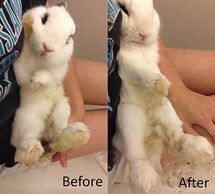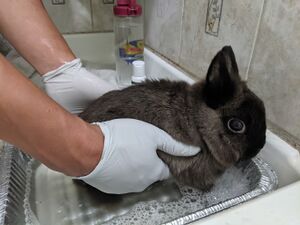Bathing rabbits
Rabbits are self-cleaning animals, much like cats. Typically, they are very well groomed, and most rabbits will only need an occasional brushing out to remove loose fur and prevent matting. Some rabbits, typically older or obese rabbits, may not keep their bottom well groomed, and the fur may be come matted with fecal matter. Otherwise, a rabbit should be clean and have no need for a bath.
If your rabbit needs a bath, something is wrong. You should find the cause of the problem, or it will consistently reoccur.
Dry baths

Generally, rabbits will not mind a dry bath. Try a dry bath first to get rid of messes before resorting to a wet bath. Dry baths are great for cleaning urine stains as well as poopy butt. It also helps to neutralize any stinging from urine burns, which the rabbit will appreciate.
Rabbits are not chinchillas and do not need regular dust baths. You can permanently scar your rabbit's eyes if you do so.
The only item you will need is baby cornstarch, available in the baby section of any supermarket. Scented or unscented is acceptable. Do not use baby powder with talc because talc is a respiratory irritant and may be carcinogenic.[1] Regular cooking cornstarch can be used as well.
Directions
The following instructions have been obtained from Dana Krempel's bathing article.[1]
- Liberally apply cornstarch to the soiled areas and gently work the powder around mess into the fur and down to the skin.
- Work the powder around any stubborn clumps of debris gently. As the cornstarch coats the mess, it will slide away easily.
- If necessary, use a fine-toothed flea comb to gently tease away dried poop or other debris. Don't pull too hard, as the bunny's delicate skin can tear surprisingly easily.
- Pat the powdered areas well to remove loose powder. If possible, have a hand-held vacuum close by to suck up the powder. Better than you and bunny inhaling it.
Spot-cleaning
For bunnies that have more irritation than a simple dry bath can take care of but not so bad that it needs a full wet butt bath, the following supplies may be helpful.
- fragrance-free hypo-allergenic grooming wipes or baby wipes - e.g. Earthbath All Natural Grooming Wipes, Wet Ones for Pets Hypoallergenic Multi-Purpose Dog Wipes with Vitamins A, C & E. Watch out for rabbit-toxic fragrances and oils like tea tree, eucalyptus, and green tea.
- incontinence cleaners or waterless shampoos with rabbit-safe ingredients - spray on urine-stained areas and pat dry. e.g. Ca-Rezz NoRisc No Rinse Wash, Spray. Watch out for rabbit-toxic fragrances and oils like tea tree, eucalyptus, and green tea.
- chlorhexidine spray - do not use on open wounds as it will sting, but it can be helpful to reduce infection and bacterial growth as a finisher before adding a barrier cream. Dilute from concentrate to around 2-4% as appropriate.
- Cavilon No-Sting Barrier Film - can be used on areas with irritated pink or red skin. It will help with protecting the area from further damage from urine.
- silvadene cream - this is a cream that needs to be prescribed by a veterinarian, but it can act as both an anti-bacterial and anti-fungal as well as a barrier cream.
- petroleum jelly and skin protectants - these ointments can help provide a barrier on the skin to protect it from further urine scald damage, but using it too often can also trap moisture against the skin and cause other issues. Appropriate skin protectants that can be used on rabbits include A&D Original ointment and smith&nephew SECURA protective ointment.
If your rabbit requires daily spot-cleaning to keep a clean bottom, please make sure to have the underlying issue diagnosed by a rabbit-savvy veterinarian. These supplies and tips are only for use in conjunction with appropriate medical treatment or until they can be seen by a veterinarian.
Wet baths
Dangers
- Bathing with water can upset or stress a rabbit, causing them to panic and inadvertently injure themselves. Any time you take a rabbit out of their comfort zone, your rabbit may go into potentially deadly shock. Rabbits can die from stress-induced heart attacks.[2] Sudden death has been reported during or after bathing rabbits.[3]
- If the rabbit struggles, because their hind legs are extremely powerful and the spine comparatively brittle and weak, they can break their back trying to get free.
- Improper soaps and shampoos may irritate a rabbit's sensitive skin and lead to infection.
- If water gets in the ears, the rabbit can get an ear infection, resulting in pain and medical bills.
- Most importantly, wet rabbit fur takes a long time to dry, and if left wet, the rabbit can easily get hypothermia, even on warm days. Also, when trying to dry fur, you may inadvertently burn the skin with the hair dryer.
By all means, a rabbit will not immediately die in the case that they get wet to the skin for whatever reason, but it is important to understand why it can be very dangerous to a rabbit's health.
Directions
If a rabbit does need a wet bath, it is important to follow proper procedures. If the problem is feces becoming matted in fur, then only the affected area should be spot cleaned.
- Use a hypoallergenic, non-medicated shampoo to wash your rabbit with. Dana Krempels writes,[1]
Some example brands on Amazon are Veterinary Formula. For urine scald, just using warm water for a rinse or an enzymatic shampoo like Zymox, HyLyt, Virbac Allergroom, or Douxo S3 PYO may be appropriate.Most popular shampoos for humans--including baby shampoos--are not recommended for use on rabbits, as they can contain harsh ingredients that are rough on delicate rabbit skin. Pet shampoos containing pyrethrins and other "herbal" or "natural" insect-killing ingredients are not recommended, either. Plants make toxic compounds to kill their herbivore pests, and just because something is "herbal" or "all natural" doesn't mean it's safe for a bunny! The best shampoo (for you or your bunny) is an organic, environmentally-friendly (and cruelty-free) product with emollients to soothe the skin, with as few additives as possible. (Bunny-safe shampoos are easy to find at natural food stores or other vendors that sell environmentally friendly products. Read the label and be a smart consumer.)
- Use a small sink, an extra litter pan, or disposable party tray with around 2.5 inches of lukewarm water to bathe the bunny. Have the water ready before placing the rabbit in so that they will not have to deal with the additional stress of seeing or hearing the water run with nowhere to go. If the bottom of the sink is smooth and slippery, place a towel so that the rabbit has some grip to stand on.
- Mix around a tablespoon of shampoo in the water until you see small bubbles.
- Being firm and gentle so that the bunny cannot jump and injure themselves, lower their rear end into the lukewarm shampoo and water mixture, and gently lave the solution onto the soiled areas until they are clean. If the bunny is very messy, you may have to change the water and do this a few times. Do not get water on their heads or in their ears. A damp paper towel or grooming wipe should be sufficient to clean off most facial messes, and ear infections are a serious danger that may permanently affect your rabbit.
- Rinse with clear lukewarm water very thoroughly, leaving NO shampoo residue. If your rabbit has a bacterial issue, you can mix in some chlorhexidine solution for disinfecting until the rinse water is tinged blue.
- Use a towel to dry the rabbit carefully and be sure not to rub too hard on irritated skin. Microfiber towels are excellent for drying as they are soft and absorb wetness better than conventional cotton or cotton blend towels.[1]
- Use a hair dryer on low to medium heat so you do not overheat the bunny, and keep it at least 12 inches from its body. Do not use the hair dryer on the head, ears or privates.[4] Having a hand close to your rabbit's skin will let you easily know if the airflow is too hot. A top loading carrier may be helpful with containing a feisty rabbit for blow drying. Use a comb or a soft brush to separate the hairs and make drying time shorter.[1] Take regular breaks with the blow drying to allow the rabbit some temporary relief from the constant noise and heat. Continue drying until the undercoat is completely dry and fluffy.
- After the rabbit is dry, carefully use blunt-tipped scissors to trim away any leftover areas where the fur is matted as well as areas where the skin is irritated. If you cannot see the skin or are doubtful where skin ends and fur begins, then do not clip! Rabbit skin is very thin and stretchy and a small wound can easily tear into a more serious wound.[1]
- Apply a soothing ointment such as calendula, A&D ointment, or a rabbit-safe triple antibiotic where any skin is irritated and needs a protection barrier. See First Aid Kit for Rabbits and the spot-cleaning section above for specific options.
Try to keep the baths as short as possible to minimize stress. If your rabbit seems abnormally stressed by the experience, stop the process and do not continue. As Dana Krempels writes,[1]
Whenever you handle a bunny, it's important to be firm, gentle and ready to release the bunny at ground level if she starts to struggle violently. As you probably know, one good kick can subluxate or even fracture the spine. Always keep the bunny's safety first in mind if you attempt a project like this.
Further reading
- DisabledRabbits.com. Baths & Cleaning
- Rabbit Welfare Association & Fund. Bathing Bunnies
- Dana Krempels, Ph.D. Bathing a Rabbit's Messy Bottom
- PDSA. Urine Scald, Dirty Bottoms and How to Clean a Rabbit
See also
References
- ↑ 1.0 1.1 1.2 1.3 1.4 1.5 1.6 Dana Krempels, Ph.D., Bathing a Rabbit's Messy Bottom
- ↑ AllExperts, Dana Krempels, Ph.D., stress-induced heart attack in rabbits
- ↑ Barbara L. Oglesbee, Blackwell's Five-Minute Veterinary Consult: Small Mammals, 2e.
- ↑ Zooh Corner, The Well Groomed Rabbit


